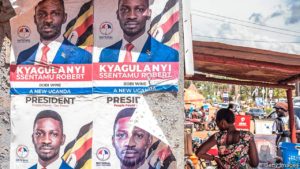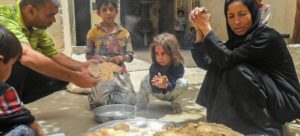A descendant of concentration camp survivors argues that using the right vocabulary can help clarify the stakes when confronting wartime trauma
Tamiko Nimura, Zócalo Public SquareDecember 28, 2023 7:15 a.m.
Out the front windows of our bus, we could see acres of sun-dried grasses during a hot and arid Northern California summer. On either side of the road stood barbed-wire fences, like the ones many of our family members spent years behind, surrounded by armed guards and guard towers, living in crowded tar-paper barracks with little to no privacy.
“How many of you have been here before or were here during World War II?” our tour guide asked. A few Japanese Americans—in their 70s and 80s, or even older—raised their hands. Many of us were stunned by what the tour guide said next, almost in passing: “Welcome back.”
Did the guide just welcome our elders back to the site of their wartime imprisonment? Dismayed murmurs arose among us.
/https://tf-cmsv2-smithsonianmag-media.s3.amazonaws.com/filer_public/30/46/3046859c-066d-4a9c-abe8-8cfaaff23fa0/japanese-american_camp_war_emergency_evacuationtule_lake_relocation_center_newell_calif_loc.jpg)
I think what the guide—a park ranger partnering with the Tule Lake Committeefor this community pilgrimage—meant was: “We are honored you have returned.” This is just one of the strange rhetorical situations I find myself in as a direct descendant of a Japanese American concentration camp survivor.
As a society, we are still developing the right vocabulary for recognizing the damage of Japanese American wartime incarceration. Because we do not have the right descriptors or labels, community pilgrimages like the one I embarked on in 2014 are misread, illegible or invisible. And indeed, the wrong language can prevent survivors and descendants from visiting former sites of Japanese American incarceration to honor our history—and to heal.
My father (who died when I was 10) and his family members were among the nearly 30,000 people incarcerated at Tule Lake, California, for close to four years during World War II. In total, the United States government imprisoned more than 125,000 “persons of Japanese descent,” most hailing from the West Coast, during the war years. Close to two-thirds of them were American citizens held without due process. The nonprofit Densho has mapped close to 100 sites of Japanese American incarceration across the country, from jails and citizen isolation centers to concentration camps and federal prison sites owned and operated by the military.
/https://tf-cmsv2-smithsonianmag-media.s3.amazonaws.com/filer_public/a1/21/a1215e49-4c95-47ce-a4ae-4cb4a18743c3/some_incarcerated_residents_used_scrap_lumber_to_build_porches_for_the_barracks_b15954d5-f335-4f49-aeb8-e52a4a971ca5.jpg)
Today, most of these sites have faded into the landscape without visible historical markers; those that remain are at risk of closing off access to community pilgrimages. One of the more publicized battles is taking place at the Minidoka concentration camp site in Idaho, where a proposed Lava Ridge wind farm threatens to put hundreds of 720-foot-tall wind turbines on the same desert land that once imprisoned more than 13,000 Japanese Americans. The National Trust for Historic Preservation named Minidoka one of the 11 Most Endangered Historic Places in 2022. Most of the camp buildings are gone, but currently, the site is open to visitors daily, with guided tours on summer weekends.
The wind farm would undo Minidoka’s potential for public education and forever disrupt the remote and desolate viewshed that visitors experience now. Adding insult to injury, in the Bureau of Land Management’s 2023 draft environmental impact statement, officials listed Minidoka as a site for “recreation.” In response, Japanese American survivors, descendants and allies from the nonprofit Friends of Minidoka mounted a powerful campaign against this terminology. “I am not a tourist,” read one poster held by protester Paul Tomita, which showed a photo of him as a young child at Minidoka. “I am a survivor.”
What’s happening in Minidoka is happening across the country. Six years ago, in 2017, I joined other Japanese American activists organizing a community protestto stop the construction of a 3-mile long, 8-foot high, barbed wire-topped fence around the Tule Lake airfield—located on the concentration’s camp grounds but currently owned by the Modoc Nation of Oklahoma—that would have effectively closed public access to the site. The indignity of another barbed wire fence on this historic site brought protests from far and wide, garnering around 50,000 letters and signatures from individuals and organizations. “We’ve lived with the fence all our lives,” wrote my late uncle, Tule Lake survivor and poet Hiroshi Kashiwagi, in a 2017 poem protesting that construction. He knew about the power of fences; that power has stayed with him and other survivors throughout their lives.
At Tule Lake, the airfield fence is just one problem. Battles between different entities have occupied stewards of the site and its history for over a decade now. These entities include the Federal Aviation Administration, the National Park Service, the City of Tulelake, Modoc County, the Modoc Nation, local farmers and ranchers, and the all-volunteer Tule Lake Committee (of which I’m a board member), which organizes biennial community pilgrimages of Japanese American survivors and descendants.
Each of these organizations has different degrees of protection, access, interest and control of portions of the full 1,100-plus-acre site where the camp originally sat, of which only 37 acres are protected as a national monument. Currently, some 359 acres of the public airfield sit in the middle of the original concentration camp footprint, where 74 blocks of barracks were located. Though these buildings were removed after the war (many of them repurposed nearby for homesteaders who won land grants), this is one of the main places Japanese American survivors and descendants want and need to visit.
Language won’t solve this tangle, but it can help clarify the stakes. Tule Lake is perhaps the most infamous of the World War II Japanese American concentration camps. Its population peaked at 18,000 in 1944, after the government administered a poorly worded questionnaire to determine incarcerated Japanese Americans’ supposed loyalty. Those who refused to swear unconditional loyalty were transferred to Tule, which became known as the camp for “troublemakers,” a segregation center for the “disloyals.” Many former Tuleans did not want to admit they were incarcerated there for decades after the war. Even within the Japanese American community, those who resisted in any way, like the No-Nos who responded in the negative to the questionnaire, including my Uncle Hiroshi, were shunned and ostracized. This history is still being reckoned with, as is its telling.
/https://tf-cmsv2-smithsonianmag-media.s3.amazonaws.com/filer_public/de/43/de431743-45c1-4845-ba52-413bfae15c17/minidoka_barracks.jpeg)
How we recognize these sites matters; how we name visitors to the site matters. During the war, government euphemisms transformed indefinite detention into “for the duration of the war” and temporary detention centers into “assembly centers.” Just ten years ago, I came to understand that “internment,” the most commonly used term, masks the reality of mass imprisonment and concentration camps. (Technically, it can be applied to first-generation Issei.) Only in the last 25 years or so has the community itself begun to apply the word “trauma” to the incarceration, and the word “survivor” to the incarcerated—the number of whom diminishes with each passing year. As Manzanar survivor and researcher Aiko Herzig-Yoshinaga once wrote, “Words can lie or clarify.” Let’s take that further: Words have lied about this history—so they should clarify how we remember it.
On that pilgrimage bus at Tule Lake, I learned that freedom looks different when seen from within a dusty jail constructed by inmates, from the base of a wooden tower once used by armed guards or next to a barbed wire fence constructed to maim anyone who crosses its path. Later, the word that described what we were doing on that journey was a surprise. We were not at Tule Lake for religious reasons. Nor were we there in any traditional pilgrimage sense: to receive blessings, or to see places where miracles happened. But I can say the reasons for our journey were transcendent, spiritual. So much so that I’d now use, hesitantly, a different word with religious overtones to describe my time there: communion.
Tamiko Nimura is a creative nonfiction writer and public historian living in Tacoma, Washington. She is completing a book, A Place for What We Lose: A Daughter’s Return to Tule Lake. This essay was written for “How Should Societies Remember Their Sins?,” a Zócalo inquiry supported by the Mellon Foundation.




